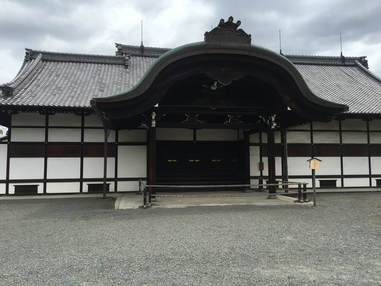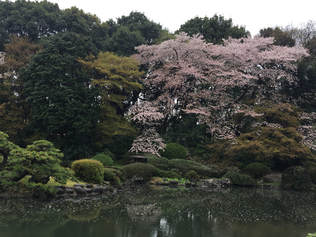|
While traveling across Japan, it is highly likely you will step into at least one temple or shrine. The architecture, history, culture, and natural beauty of temples and shrines make them great places to visit. There are a few rules you may not be familiar with that are common across the country. It is important to follow the rules to help preserve these religious sites and allow others to have a pleasant experience. Take Shoes Off Before Entering a Building This may seem basic, but it is not always obvious to visitors that you are expected to remove footwear before entering buildings. There is an area you can take shoes off and put them in a storage bin or leave to the side. Slippers are typically provided by the site for visitors to use while touring the interior. It is acceptable to walk around in socks if your feet are too big to fit into slippers. If you wear a men's size 10 or larger shoe, you should plan to wear thicker crew socks as a precaution. Follow the Guide Arrows and Path It is important to travel along the designated route inside buildings to help keep the flow of foot traffic moving. You may be asked to not stop along the way if the site is very busy and crowded. In addition, staying on pathways prevents damage to the grounds and floorboards not protected for visitors. Do Not Take Photos Where Prohibited There may be signs posted asking visitors to refrain from taking flash photos or pictures in general. One reason for this is to protect paintings and other art from damage and deterioration due to the intensity of a camera flash. Another is to prevent traffic from slowing down due to everyone taking a picture of the same thing. Third, temples and shrines want to prevent pictures taken of treasured artifacts and encourage gift shop sales. Regardless of the reasoning, you should respect the signs posted. You Can Participate in Various Cultural Practices When visiting a temple or shrine, you may see other visitors breathe incense or take a sip from flowing water with a wooden cup or other instrument. It is acceptable to follow their lead by saying a prayer and also partaking in these cultural practices. Ask About Shuinchou Stamps Before Taking a Tour You should ask how each temple and shrine stamps a shuinchou book or look for signs upon entering, The reason is because some places are busy and will collect them at the beginning of a tour to complete. Others may give a pre-made insert to put in a book. The most enjoyable experience is watching someone create the stamp, but this is not always the case. Keep in mind that not all temples and shrines provide stamp opportunities for a shuinchou. Japan is not the only country that has a cherry blossom season. The Tidal Basin around the Jefferson Memorial in Washington, D.C. is another such place. This area is full of cherry blossom trees given to the United States by Japan. Each spring, the blossoms go into full bloom for locals and tourists to enjoy. The timing various depending on the weather just like in Japan. An annual festival known as the National Cherry Blossom Festival is held around the blooming time period. The festival hosts multiple activities and events in the heart of Washington D.C. The history of how the cherry blossom trees were donated and more about the National Cherry Blossom Festival can be found here. Another great resource for blooming forecasts is the full bloom watch for Washington D.C. found here. This site gives updates on the latest information for peak blooming and previous season information. The average full bloom time period is similar to that of Japan. You should expect the peak bloom in Washington D.C. to occur, on average, between the last week of March and the first week of April. It is quite the spectacular and you should expect a plethora of tourists and traffic during the peak bloom period.
Tokyo is a huge city. When factoring in population density and land area, it is one of the largest cities in the world. Seeing all of Tokyo in one trip to Japan is an unreasonable expectation. It is important to narrow down activity options and think about what are the highest priorities for you. Making a short list will help guide you as to what area of Tokyo is the best fit for you. Follow the Narita Express One of the easiest ways to decide where to stay in Tokyo is to pick a stop along the Narita Express (NEX). The express train from Narita Airport drops passengers off at major areas of Tokyo including Shibuya, Shinjuku, Tokyo Station, Ikebukuro, and Yokohama. There are plenty of lodging options around these stations. Getting back on the NEX to take a flight out of Tokyo is also convenient when staying near a station on the NEX route. Stay Along the Yamanote Line One of the best JR Rail transportation options is the Yamanote Line that runs in a full circle around Tokyo. This line stops at over 20 different destinations including some of the biggest tourism areas. Staying near the line simplifies navigating the complex transportation network of Tokyo. You can easily access the Yamanote Line by stopping at Tokyo Station after riding the NEX from Narita Airport. Pick a Neighborhood to Explore There are a few neighborhoods that cater to nightlife, shopping, and other interests for tourists. Do you want to experience a bar scene and some night life? Shinjuku or Roppongi may be of interest to you. If shopping is a high priority, then you may be interested in the Ginza area. There are certainly benefits to staying in a particular place such as saving travel time and close proximity for carrying shopping bags. Other things to consider when choosing a location to stay is price, amenities, and even how many people are traveling with you. Also note that public transportation does not run all night long and taxis are expensive. Picking an area to make your home base can enhance your experience and allow time for more of your favorite activities. Typically, during the last week of March is when you can view the cherry blossoms in full bloom around Tokyo, Japan. This cherry blossom tracker is a great resource each spring to see the expected blossoming time by region. The blooming times vary each year which makes it hard to plan correctly ahead. If you are fortunate enough to be in Tokyo during the blooming time-frame, then definitely take advantage of it. Here are a few suggestions for viewing spots based on personal experience. Shinjuku Gyoen Park This park is located in the heart of Shinjuku and features a large amount of cherry blossom trees. There is a small admission fee to enjoy the large park and its multiple gardens. You should definitely take your time and enjoy the beautiful landscapes in Shinjuku Gyoen Park. Ueno Park Another great park with wonderful cherry blossom trees is Ueno Park. This park is very popular for picnics during cherry blossom season. You will find a large crowd of people in the park spending time with friends and enjoying the blossoms. The park also contains multiple national museums and a zoo. They are all worth visiting if you have the spare time. Sumida Park A park located along the Sumida river covered with cherry blossom trees. It is a great place to stroll through. The trees are also illuminated in the evenings during Cherry Blossom season. Also, Sumida park is a less than ten minute walk from Asakusa Shrine. |
Follow me
on Instagram @card_knock_life Categories
All
Archives
July 2024
This website contains affiliate links
|











 RSS Feed
RSS Feed
